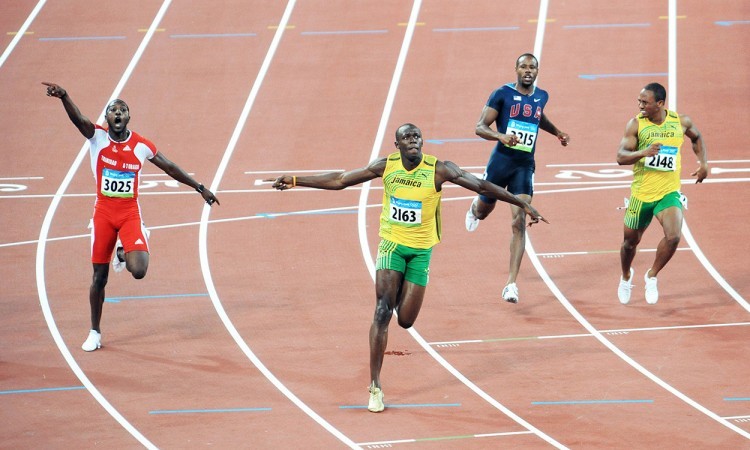Athletics Weekly celebrates 70 years of the publication this month and we marked the milestone with a special celebratory edition on December 3.
 Features inside include a look at the founding of AW, the development of the publication over the years and an article highlighting when we first mentioned some of the stars of the sport in our pages.
Features inside include a look at the founding of AW, the development of the publication over the years and an article highlighting when we first mentioned some of the stars of the sport in our pages.
We also look back on some of the most memorable moments from the past 70 years and here they are, featured in no particular order...
Roger Bannister created history when he clocked 3:59.4 at Iffley Road on May 6, 1954.
Helped by his training partners and pacemakers Chris Brasher and Chataway, Bannister scaled the Everest of athletics with a performance that is often described as the most significant athletics achievement of modern times.
AW’s original report appeared in the May 15 issue in 1954 and was written by George Pallett, a British long jump international and athletics writer who died in 1996 aged 88.
Pallett wrote: “So the Everest of athletics has been scaled, the sound barrier of running has been penetrated. Roger Gilbert Bannister, twenty-five-year-old medical student, may never find the panacea for all ills the human flesh is heir to, but he has found the philosopher’s stone of sport.”
On the closing stages of the race, Pallett continued: “An avalanche of humanity began to pour from the stands as Bannister was seen to draw out and begin the last, long pull to the tape; a slight lengthening of the stride, his arms driving harder to maintain the almost majestic cadence of his action – his fluent power gave no hint of fatigue.”
Widely regarded as perhaps the most thrilling footrace on British soil, Chris Chataway outsprinted Vladimir Kuts in front of a huge audience at the White City over 5000m in October 1954.
It earned Chataway, who had been a mere pacemaker for Roger Bannister in the first sub-four-minute mile a few months earlier, the BBC Sports Personality of the Year award.
Chataway’s time was a world record of 13:51.6 but it was the nail-biting victory in this London v Moscow match that captured everyone’s imagination.
AW founder and editor Jimmy Green wrote: “It is surprising how the Kuts-Chataway duel at the White City stirred people who, in the past, have shown little or no interest in athletics.”
He added: “This shows how such races – and the televising of them – can stimulate interest in our sport.”
The Olympic icon of the 2000 Games, Cathy Freeman lit the cauldron and then won her 400m race in style in front of a packed home crowd of more than 110,000 spectators on a night that was later dubbed ‘Magic Monday’.

The session fell bang on AW’s deadline and the four-man reporting team in Sydney, led by editor Jason Henderson and photographer Mark Shearman, rattled out reports from Freeman’s 400m final, the Haile Gebrselassie v Paul Tergat 10,000m battle, Jonathan Edwards’ triple jump victory and Kelly Holmes’ 800m bronze medal-winning performance within minutes of each event finishing so that the design and production team back in the UK could lay the words and pictures out on the pages.
AW’s report began: “Forget about Sydney flu. Anyone entering Australia before these Games couldn’t avoid being bitten by a much stronger bug: Freeman fever.
“The Aboriginal icon, described in Australia as a mix between Princess Diana and David Beckham, such is her fame, had the pressure of a nation riding on her slim shoulders – and she did not disappoint.”
Amusingly, the reports also mentioned that Freeman doesn’t read articles written about herself. “It’s my survival tool,” she said, before adding that she had one exception: “Of course I read AW!”
Mike Powell's win over Carl Lewis in the long jump at the 1991 IAAF World Championships is widely regarded as the greatest field events contest in history.
Both athletes jumped further than Bob Beamon’s 23-year-old world record and Powell’s 8.95m set at these World Championships in Tokyo still stands as the world record today.
AW’s front cover at the time featured world 10,000m champion Liz McColgan with the headline at the side “Leap year – Mike Powell breaks Bob Beamon’s long jump world record”. But a few issues later Powell got his deserved place on the AW cover.
Writing for AW in Tokyo, James O’Brien said “it was the most remarkable long jump competition of all time, one in which the defending champion produced his finest series of his career yet still had to settle for the silver medal”.
Elsewhere, AW described the event as “a monumental slice of track and field history”.
In Sydney in 2000 we had Magic Monday, but the Super Saturday in 2012 arguably surpassed it mainly due to the massive success from the home nation. The crowd in the London Olympic Stadium saw victories from Jessica Ennis in the heptathlon, Greg Rutherford in the long jump and Mo Farah in the 10,000m on a dazzling night charged with emotion and atmosphere.

AW’s coverage from major championships is usually split over two issues. The first issue takes in the opening weekend, which traditionally involves the blue riband 100 metres and events like the heptathlon. Then, our second issue, covers the last half of the championships. Super Saturday was on the opening weekend in London and our cover featured images of the three British gold medallists plus Usain Bolt with the mini-headline “lightning really does strike twice”.
All of these athletes had been featured in AW many years earlier. For example Rutherford was in our pages being soundly beaten in the English Schools championships as a young boy, while Bolt was featured – with an image – winning the world junior title in 2002.
Here, in London, they were all on top form and AW called Super Saturday “the greatest night in British athletics, probably even in British sport”.
Mary Decker's tangle with Zola Budd in the Olympic 3000m final at the 1984 Los Angeles Games is one of the most controversial moments in sporting history and is still debated today.
America’s reigning world champion was pitted against a barefoot teenage prodigy from South Africa who had been swiftly given a British passport on the eve of the Games, but Decker ended up on the in-field after tripping and Budd was booed home in seventh place as Maricica Puica of Romania took gold from Britain’s Wendy Sly.
Mel Watman wrote in AW’s report from LA: “My heart went out to Mary as she lay twisting in agony even though it was her refusal to back down that led to the disaster. She had made an error, born perhaps of her own relative lack of experience running in tightly packed fields. However, when the booing started, my sympathies transferred to Zola, running with tears in her eyes amid a wave of public antagonism.”
Usain Bolt would later run faster in the IAAF World Championships in Berlin, but the Beijing Olympics in 2008 is where the Jamaican first truly made a name for himself with victories and world records in the 100m, 200m and 4x100m.

“Until this month,” AW’s report began at the conclusion of the 2008 Games, “Beijing was best known for Tiananmen Square, the Forbidden City and its famous crispy duck. Now, it will be associated forever with the iconic Bird’s Nest stadium and the sporting exploits of Usain Bolt.
“Such was his impact in these Games, if he maintains his form in the years to come he could match or surpass the exploits of Carl Lewis, Jesse Owens and Michael Johnson. There have even been some comparisons with boxer Muhammad Ali.”
The men’s 100m sprint in Seoul has been called ‘the dirtiest race in history’ and was dominated by Ben Johnson, who broke the world record and subsequently tested positive for steroids.
“Johnson disgrace” was the headline emblazoned on the front of AW’s September 30 issue that year, while inside the magazine the pages were full of smaller headlines like “Fall of a champion” and “Countdown to a crisis” as the whole sorry story was chronicled in our pages.
“Monday was a good day for athletics,” wrote the editor of AW at the time, Keith Nelson, “and don’t let anyone tell you otherwise.”
He continued: “Yes, the whole world was stunned by the news about Ben Johnson. No, I don’t want to believe it. But it is true. He was a cheat and he has been caught.”
Nelson added: “This is the first significant case victory for the anti-drugs campaigners. The IOC has stood firm and kicked out the ‘winner’ of the most spectacular sprint race in history.”
Paula Radcliffe's 2:15:25 world record for 26.2 miles in London in 2003 has not been remotely challenged in the last dozen years and is one of the strongest records in the book, if not the best.

When she did it, the Bedford athlete topped the UK rankings for the year – ahead of the entire British male population, let alone women.
“The Oxford English Dictionary should consider a new word for its pages,” wrote AW’s editor Jason Henderson in the April 16 issue in 2003. “Radcliffesque: total dedication and bloody-mindedness, especially regarding the pursuit of sporting excellence.”
He added: “Paula ran some parts of her marathon at sub-five- minute mile pace. Yet only half a century ago women found it impossible to break five minutes for a mile and it was not until 1954 that Britain’s Diane Leather became the first female to break the barrier.
“If this former asthmatic, who once struggled to a mere 299th in the national cross country championships, can perform such feats, then what can the rest of us achieve if we set our minds to it?”
Such was the success of AW’s coverage of the careers of Seb Coe and Steve Ovett, a spin-off book was published entitled The Coe & Ovett File and it consisted entirely of clippings from this magazine’s coverage.
The highlight was Moscow in 1980 where Ovett famously won the 800m before Coe got revenge in the 1500m. AW editor Mel Watman did not mince his words either, writing after the 800m: “Steve Ovett ran so physical a race that he can consider himself lucky not to have been disqualified, while Seb Coe chose an Olympic final of all occasions to run the most abysmal race of his career.
“Instead of the full-blooded battle we had been anticipating so excitedly, the race turned out to be an untidy, ill-mannered affair won in the modest time of 1:45.4.”
On the 1500m, Watman wrote: “At no point in the race, from the shuffling beginning to the flat-out sprint finish, was Coe ever outside the first two places and he was at all times well poised either to launch his own strike or cover anyone else’s. Instead of the hesitant near-novice of the 800m final, here was a man in complete control.”
» This feature was first published in the December 3 edition of AW magazine which celebrates 70 years of the publication. You can order a copy of that edition here, or download a digital edition here
